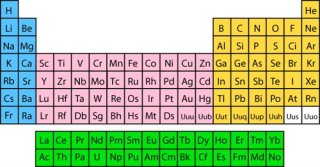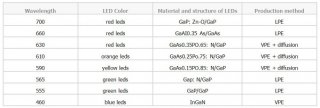 Chemistry
Chemistry
When the LED first became commercially available, over 40 years ago, no one really paid much attention to how it was made or what it consisted of chemically. This was in part due to the fact that only a few basic types and colors were available (such as GaP - red and green, and GaAsP - yellow). Today, in order to obtain new colors, or wavelengths, and improve performance and reliability, there are many new types of chemical structures being created. Because of this, LEDsare no longer referred to strictly by their color but also by their chemical name, such as InGaAlP or GaAlAs. If the user is not familiar with LED technology or does not have a degree in chemistry and materials, this hodgepodge of letters can be very confusing. The following information is provided to help alleviate some of this confusion.
Gallium
The first and primary element used in the manufacture of almost all semiconductor LED devices is gallium. Gallium is a metallic material which is found as a trace element in coal, bauxite and other minerals. The symbol for gallium is "Ga" - (atomic number 31). When combined with arsenic "As" (atomic number 33), a highly poisonous gray metallic element, at temperatures of about 4000 degrees Fahrenheit, the compound gallium arsenide "GaAs" is formed. This dark gray crystalline compound is the basis for the original semiconductor LEDs manufactured almost 40 years ago. When current/energy is applied to this material, photons or particles of light are emitted. GaAs by itself emits light in the infrared range which is not visible to the human eye, however, if another element, phosphorus (a highly reactive white or yellow, non-metallic element, occurring naturally in phosphates, with atomic number 15 and symbol "P") is introduced, a mixed crystal of gallium aresenide phosphide "GaAsP" is formed. Depending on the proportional amount of phosphorus, light in the visible range from red to yellow is achieved.
In addition to GaAsP described above, the material combination gallium posphide "GaP" was developed. By properly doping this crystal compound, various colors could be obtained. For example, by adding zinc-oxygen to GaP, the color red is obtained. By adding nitrogen, green light is achieved. It is important to note that in almost all semiconductor LED die material, the added elements such as zinc, nitrogen, beryllium etc. are not usually specified in the general material structure acronym. All of the materials mentioned above although developed many years ago, are still widely available and in use today. (Table. 1)
Aluminum
In the late 1970's, it was discovered that by adding aluminum "Al" (atomic number 13, and the most abundant metallic element in the earth's crust) to the GaAs compound, a red color could be produced with a brightness and efficiency significantly increased over existing product. Thus, gallium aluminum arsenide "GaAlAs" was formed. Although the combination of gallium, aluminum and arsenic have been around for approximately 30 years, the actual format for the elemental configuration varies. Some manufacturers depict the compound as AlGaAs while others call it GaAlAs. Originally, many thought that the material designated first was found in greater quantities than the succeeding elements. If GaAlAs was the designation, then Ga (gallium) was the primary element in the compound. Al (aluminum) would be second and As (arsenide) would be third. This caused many users to believe that if the element order was different, each of the compounds was significantly different. This is an incorrect assumption. The order each element is placed in the compound does not follow standard chemical sequences nor is it required to do so since the exact chemical structure is not specified. GaAlAs are only the "primary" elements used in the compound. All other additional elements or dopants such as zinc or nitrogen and their exact compositions are not listed. Essentially, the only difference between GaAlAs and AlGaAs is in the way the acronym is written.
 Recently, this mish-mash of letters and material types has been even further complicated by the introduction of many new compounds such as indium gallium aluminum phosphide "InGaAlP." With the addition of indium "In" (a soft malleable silvery white metallic compound found primarily in zinc and tin ores with atomic number 49) it was found that not only would the LEDs brightness and efficiency be improved, but the actual lifetime would be significantly increased over current materials such as GaAlAs. Furthermore, with proper doping, a wide variety of colors and wavelengths can be produced. Similar to gallium aluminum arsenide, the acronym for indium gallium aluminum phosphide can be expressed in a number of ways. The two most common are InGaAlP and AlInGaP. Both forms are chemically the same material.
Recently, this mish-mash of letters and material types has been even further complicated by the introduction of many new compounds such as indium gallium aluminum phosphide "InGaAlP." With the addition of indium "In" (a soft malleable silvery white metallic compound found primarily in zinc and tin ores with atomic number 49) it was found that not only would the LEDs brightness and efficiency be improved, but the actual lifetime would be significantly increased over current materials such as GaAlAs. Furthermore, with proper doping, a wide variety of colors and wavelengths can be produced. Similar to gallium aluminum arsenide, the acronym for indium gallium aluminum phosphide can be expressed in a number of ways. The two most common are InGaAlP and AlInGaP. Both forms are chemically the same material.
Group III and Group V Elements
Elements such as (Al, Ga, and In) are called group "III" elements while (P, As, and N) are group "V" elements. Light emitting semiconductor product is typically referred to as "III-V" material derived from the periodic table. Other compounds such as silicon carbide "SiC" which combines silicon (a non-metallic element occurring extensively in the earth's crust in silica and used for the manufacture of glass, semiconductor devices, pottery etc. with atomic number 14) and carbon (a naturally abundant non-metallic element occurring in all organic or living organisms with atomic number 6) and gallium nitride "GaN" are used in the manufacture of blue and green LEDs. The acronym for these compounds is generally consistent throughout the industry, although it could be transposed at any time.
Once a chemical compound has been established, the acronym describing that substance can be very subjective to the whims of the manufacturer or developer. It is important to note that one compound should not be misconstrued as being superior or inferior to another compound with the same chemical composition, but a different chemical order.
 A heterojunction is the interface that occurs between two layers or regions of dissimilar crystalline semiconductors. These semiconducting materials have unequal band gaps as opposed to a homojunction. It is often advantageous to engineer the electronic energy bands...
A heterojunction is the interface that occurs between two layers or regions of dissimilar crystalline semiconductors. These semiconducting materials have unequal band gaps as opposed to a homojunction. It is often advantageous to engineer the electronic energy bands...